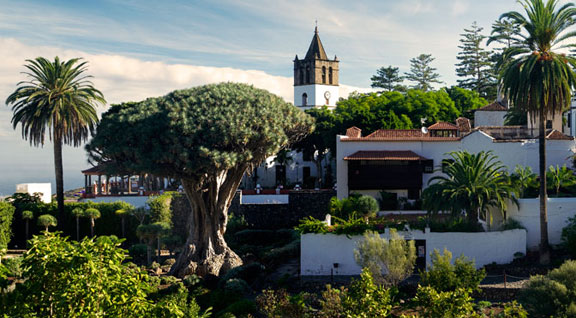In the previous article we discovered some of the most beautiful towns on the island of Tenerife. Obviously, there were many that fell out of the standings. For this reason we have decided to make a second part of the most charming towns in Tenerife. After talking about Masca, La Laguna, La Orotava, Garachico or El Puerto de la Cruz, today we are going to discover other towns on this Canary Island that dazzle visitors with their heritage, cultural, natural, historical or gastronomic attractions. So now you know, buy the flights, book a transfer in Tenerife to your accommodation and get ready to enjoy an experience with all five senses on this dream island.
El Sauzal
If you are on a route through the north of the island of Tenerife, El Sauzal deserves a stop. It is a small and pretty town, with a delightful historic center that is easily visited on foot, despite having some steep slopes. But that is something that is part of its charm. Because from El Sauzal you can enjoy some of the best sunsets in the world. In fact, the sunsets from the terraces and viewpoints that the town treasures are a real delight and, moreover, free.
Icod de Los Vinos
It is also located in the northern part of Tenerife, between the towns of La Orotava and Garachico. As its name suggests, it is famous for the variety and quality of wines produced in its municipality. In fact, the island of Tenerife has several designations of origin certified for the quality of the grape wines. That is why it is the perfect place to do some wine tasting in the area. Icod de los Vinos may not stand out for the beauty of its buildings, but it does have a unique natural attraction in the world, the Ancient Dragon Tree, a symbol of the Canary Islands. It is a tree that is endemic to the Canary Islands, is about 18 meters tall, has a crown diameter of approximately 20 meters and has a perimeter at the base of the trunk of another twenty meters, in addition to some three hundred main branches.
Very close to there, you can also visit the Cueva del Viento, one of the largest volcanic tubes in the world, specifically the fifth. Keep in mind that the other four are in the Hawaiian archipelago. This tube was formed about 27,000 years ago from basaltic lava from the first phase of the eruption of the Pico Viejo volcano, located next to Mount Teide.
Tegueste
The Villa de Tegueste, with a long agricultural tradition, rises next to the Anaga mountain range, in the northeast of the island of Tenerife. We are talking about a small place, with several well-cared examples of typical traditional Canarian architecture, and that in recent years has managed to position itself as a top-level wine tourism destination. In this place, one of the largest pilgrimages in the Canary Islands is held every year, that of San Marcos, also known as the Pilgrimage of Tegueste, and where you can see the Dance of the Flowers, a tradition that is still preserved and that has more than five centuries of history.
Arico
We have moved a lot around the north of the island of Tenerife, but the south also has very charming towns. One of the best examples is Arico. Arico el Nuevo barely has 180 inhabitants and the town is built in a very inaccessible place. History tells us that the town was founded in the middle of the 18th century when springs of water were detected in the surroundings of Arico. It has been declared a Historic Site and a few old mansions are still preserved, with simple facades, but with typical elements. Nearby you can also visit the Villa de Arico, the capital of the municipality, founded in 1590. The old town has also been declared a Historic Site, highlighting above all the beautiful Church of San Juan Bautista, a Historic Monument- Artistic since 1985. As a curiosity, it is worth mentioning that Arico is the second largest municipality in all of Tenerife and can also boast of having small coastal towns.
Vilaflor
This charming town is located on the southern slopes of Teide, a charming inland town that is the perfect place for all lovers of hiking and nature. This town has always been a place of passage for the interior routes of the island and today it is surrounded by pine forests that give it a unique rural appearance. In addition, it has several historical buildings such as the hermitage of San Roque or that of Calvario.


Leave A Comment